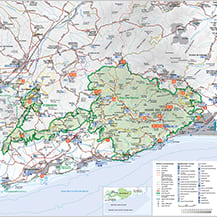Jupiter
He is our big brother. So big that 1,300 Earths could fit inside. We couldn't set foot on it. It is a huge sphere of gas (hydrogen and helium). Its presence in the Solar System prevents asteroids from moving without restrictions, with the risk of impacts that this would entail. This fact has surely made possible a highly evolved life on Earth. Astronomers of antiquity correctly associated it with the King of the Gods.
| Diameter | Jupiter is 142,984 km in diameter and here it is 14.3 cm, a little smaller than a handball. |
| Duration of the day | On Jupiter the day would fly by. It only lasts for 9 hours 55 minutes. |
| Year duration | Years would pass us slowly, instead. One Jovian year equals 11.9 Earth years. |
| Distance to the sun | The giant is 5 times farther from the Sun than we are, at 778.5 million km. At 778.5 meters from the Sun in this model represented at Garraf. |
| Satellites | Currently 79 satellites are known, although the best known are the four discovered by Galileo: Io, Europa, Ganymede and Callisto. The third one is larger than the planet Mercury. |
| Composition | It is a huge sphere of gas, mostly hydrogen and helium. The clouds that form the alternately light and dark belts contain water, ammonia, and ammonium disulfide with traces of phosphorus, sulfur, and hydrocarbons. |
| At the level of the atmosphere equivalent to the pressure of a terrestrial atmosphere, the temperature is 108 °C below zero. Inside, they will surely reach 50,000 ° C. |
| Gravity | At this giant we would notice a weight 2.52 times higher than what we notice at home. |
| Density | It is slightly denser than water: 1.3 g / cm³. The same density of wool! |
| Did you know... | … That since Jupiter is a gaseous planet, does the rotation speed vary at different latitudes? This is called differential rotation, and it is common to all gaseous planets and "normal" stars. … That In the sky Jupiter is a very bright point that shines thanks to the light that comes from the Sun? You can calculate how intense the sunlight reaches it, keeping in mind that it decreases with the square of the distance. If Jupiter is about 5 times farther from the Sun than we are, what is the fraction of light and heat that reaches it compared to what we receive on Earth? How come it’s still so bright? … That being made of gas, giant planets are very deformable? This fact, combined with their rapid rotation, makes them look very flattened. In the case of Jupiter, the polar diameter is almost 10,000 km smaller than the equatorial diameter. |
-
See if it is currently visible to the naked eye at www.planetari.cat/planetes


























